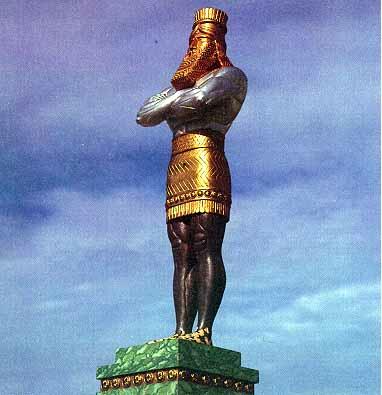1. Look for the waymarks as you journey on,
Look for the waymarks, passing one by one;
Down thro’ the ages, past the kingdoms four—
Where are we standing? Look the waymarks o’er.
Refrain
Look for the waymarks, the great prophetic waymarks,
Down through the ages, past the kingdoms four.
Look for the waymarks, the great prophetic waymarks;
The journey’s almost o’er.
2. First, the Assyrian kingdom ruled the world,
Then Medo-Persia’s banners were unfurled;
And after Greece held universal sway,
Rome seized the scepter—Where are we today?
Refrain
3. Down in the feet of iron and of clay,
State mixed with church, but soon to pass away;
What will the next great, glorious drama be?
Christ and His coming, and eternity.
Refrain
Playback
Instrumental – Sampled Sounds
Download
| MP3 – Instrumental | PNG | |
| MIDI | XML | EPS |
| TXT | SIB7 / SIB3 | SVG |

Traditionally (and as Uriah Smith explains in his comments from the book Daniel and the Revelation, Part I, Chapter II, p. 60-63) Adventists have understood the ten toes to correspond to the ten horns of Daniel 7, which were the nations that the Roman Empire split into when it decayed.
However, the image of Daniel 2 extends further down the prophetic line, since it represents the earthly powers in existence when the stone of Christ’s kingdom smites the feet of the image. Therefore, the ten toes more accurately represent the…
Revelation 17
12…ten kings, which have received no kingdom as yet; but receive power as kings one hour with the beast.
These “ten kings” do not have power yet, so they cannot be any kingdoms that already exist.
The last beast (or power) formed before Christ returns is the “image of the beast” (Revelation 13:14,15).
The original beast was a combination of corrupt church (Roman Catholicism) and State (the various nations of Europe). This corresponds nicely with the miry clay and iron of the feet of the image in Daniel 2.
And so the “image of the beast” must be a reproduction of that original; a combination of apostate church (miry clay) and state (iron).
The “ten kings” are those who reign with the last of the world empires. Therefore they especially correspond to the ten toes of the image of Daniel 2.
As well, since the toes are made of the same material as the feet (iron and clay mixed) these ten kings also must be formed by the combination of religion and state. They symbolize a worldwide union of religion and state, most likely involving all the different religions of the world in unification, attempting to solve the world’s problems.
The image begins in America, since it is constructed by the “two-horned beast” that arose “out of the earth“. The “two horns like a lamb” represent the good and peaceful principles of Religious and Civil Liberty, upon which America was founded, and which made her different and stronger than the other nations of the world. Originally, these were noble principles, but this power “speaks as a dragon” which indicates a loss of these noble principles.
The example of America, in attempting to implement a church-state union to solve the world’s problems, is a direct transgression of the principles on which she was founded. This example will be followed by all the rest of the nations, who will likewise be desperate for a solution to the growing worldwide distress. This would be the final constitution of the ten toes.
The mingling of churchcraft and statecraft is represented by the iron and the clay.
– The SDA Bible Commentary, vol. 4, p. 1168-1169
To reflect this truth, one line in the song above was changed (thanks Rina for pointing this out!).
You can find a more full explanation of the topic of the image beast and the ten horns here: Churchcraft and Statecraft.














It would be nice to have a footnote in the re-written line to rever to the comment above. That is a pretty big change and I was lucky to actually read the comments to find the change. I don’t disagree with the change, in fact I don’t know enough to refute or advocate it. Thanks for the post though. I was not familiar with the hymn and your discussion of separation of church and state intrigued me with the current “state” of our nation.
I really appreciate your website. I have a question for you. Where did you find the lyrics “State mixed with church, but soon to pass away” instead of “Weak and divided soon to pass away”? Thank you!
Rina,
I re-wrote that line. (You must be very familiar with the song, as most people probably wouldn’t have caught that detail!).
I have now updated the song comments to explain the change.